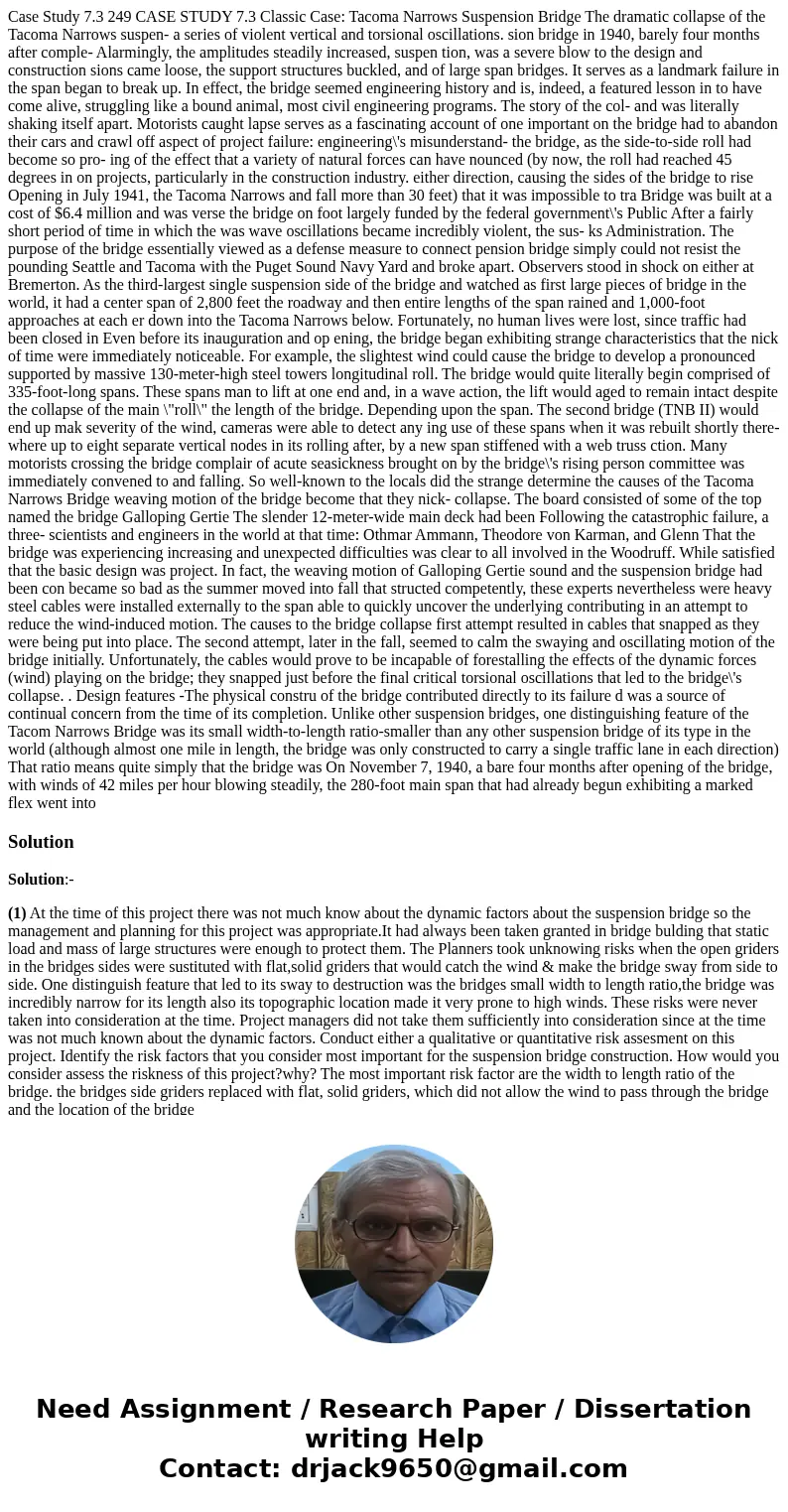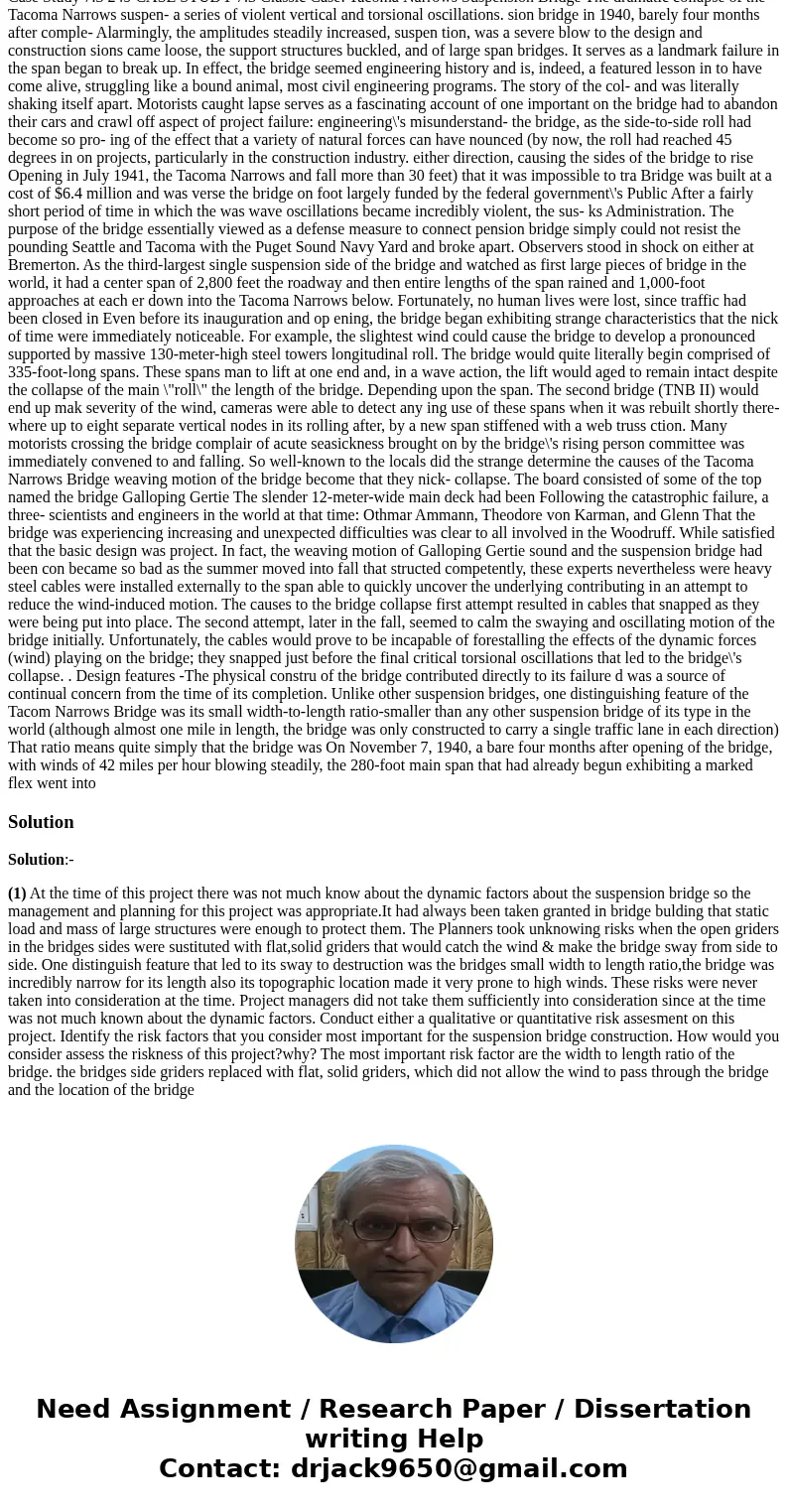Case Study 7.3 249 CASE STUDY 7.3 Classic Case: Tacoma Narrows Suspension Bridge The dramatic collapse of the Tacoma Narrows suspen- a series of violent vertical and torsional oscillations. sion bridge in 1940, barely four months after comple- Alarmingly, the amplitudes steadily increased, suspen tion, was a severe blow to the design and construction sions came loose, the support structures buckled, and of large span bridges. It serves as a landmark failure in the span began to break up. In effect, the bridge seemed engineering history and is, indeed, a featured lesson in to have come alive, struggling like a bound animal, most civil engineering programs. The story of the col- and was literally shaking itself apart. Motorists caught lapse serves as a fascinating account of one important on the bridge had to abandon their cars and crawl off aspect of project failure: engineering\'s misunderstand- the bridge, as the side-to-side roll had become so pro- ing of the effect that a variety of natural forces can have nounced (by now, the roll had reached 45 degrees in on projects, particularly in the construction industry. either direction, causing the sides of the bridge to rise Opening in July 1941, the Tacoma Narrows and fall more than 30 feet) that it was impossible to tra Bridge was built at a cost of $6.4 million and was verse the bridge on foot largely funded by the federal government\'s Public After a fairly short period of time in which the was wave oscillations became incredibly violent, the sus- ks Administration. The purpose of the bridge essentially viewed as a defense measure to connect pension bridge simply could not resist the pounding Seattle and Tacoma with the Puget Sound Navy Yard and broke apart. Observers stood in shock on either at Bremerton. As the third-largest single suspension side of the bridge and watched as first large pieces of bridge in the world, it had a center span of 2,800 feet the roadway and then entire lengths of the span rained and 1,000-foot approaches at each er down into the Tacoma Narrows below. Fortunately, no human lives were lost, since traffic had been closed in Even before its inauguration and op ening, the bridge began exhibiting strange characteristics that the nick of time were immediately noticeable. For example, the slightest wind could cause the bridge to develop a pronounced supported by massive 130-meter-high steel towers longitudinal roll. The bridge would quite literally begin comprised of 335-foot-long spans. These spans man to lift at one end and, in a wave action, the lift would aged to remain intact despite the collapse of the main \"roll\" the length of the bridge. Depending upon the span. The second bridge (TNB II) would end up mak severity of the wind, cameras were able to detect any ing use of these spans when it was rebuilt shortly there- where up to eight separate vertical nodes in its rolling after, by a new span stiffened with a web truss ction. Many motorists crossing the bridge complair of acute seasickness brought on by the bridge\'s rising person committee was immediately convened to and falling. So well-known to the locals did the strange determine the causes of the Tacoma Narrows Bridge weaving motion of the bridge become that they nick- collapse. The board consisted of some of the top named the bridge Galloping Gertie The slender 12-meter-wide main deck had been Following the catastrophic failure, a three- scientists and engineers in the world at that time: Othmar Ammann, Theodore von Karman, and Glenn That the bridge was experiencing increasing and unexpected difficulties was clear to all involved in the Woodruff. While satisfied that the basic design was project. In fact, the weaving motion of Galloping Gertie sound and the suspension bridge had been con became so bad as the summer moved into fall that structed competently, these experts nevertheless were heavy steel cables were installed externally to the span able to quickly uncover the underlying contributing in an attempt to reduce the wind-induced motion. The causes to the bridge collapse first attempt resulted in cables that snapped as they were being put into place. The second attempt, later in the fall, seemed to calm the swaying and oscillating motion of the bridge initially. Unfortunately, the cables would prove to be incapable of forestalling the effects of the dynamic forces (wind) playing on the bridge; they snapped just before the final critical torsional oscillations that led to the bridge\'s collapse. . Design features -The physical constru of the bridge contributed directly to its failure d was a source of continual concern from the time of its completion. Unlike other suspension bridges, one distinguishing feature of the Tacom Narrows Bridge was its small width-to-length ratio-smaller than any other suspension bridge of its type in the world (although almost one mile in length, the bridge was only constructed to carry a single traffic lane in each direction) That ratio means quite simply that the bridge was On November 7, 1940, a bare four months after opening of the bridge, with winds of 42 miles per hour blowing steadily, the 280-foot main span that had already begun exhibiting a marked flex went into
Solution:-
(1) At the time of this project there was not much know about the dynamic factors about the suspension bridge so the management and planning for this project was appropriate.It had always been taken granted in bridge bulding that static load and mass of large structures were enough to protect them. The Planners took unknowing risks when the open griders in the bridges sides were sustituted with flat,solid griders that would catch the wind & make the bridge sway from side to side. One distinguish feature that led to its sway to destruction was the bridges small width to length ratio,the bridge was incredibly narrow for its length also its topographic location made it very prone to high winds. These risks were never taken into consideration at the time. Project managers did not take them sufficiently into consideration since at the time was not much known about the dynamic factors. Conduct either a qualitative or quantitative risk assesment on this project. Identify the risk factors that you consider most important for the suspension bridge construction. How would you consider assess the riskness of this project?why? The most important risk factor are the width to length ratio of the bridge. the bridges side griders replaced with flat, solid griders, which did not allow the wind to pass through the bridge and the location of the bridge


 Homework Sourse
Homework Sourse